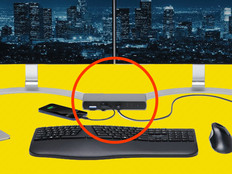Multiple Choice
Buying computers for a government agency is challenging. You must first analyze your organization’s needs and requirements so you can identify what hardware will provide an appropriate solution.
The type of computer to purchase for a given application or department falls broadly along these lines:
• Desktops — Here are the workhorse computers for most agencies. With the most bang for the buck, desktop PCs are right for anyone who doesn’t need to take the computer home or on the road. Desktops are also important for users with specialized applications that demand a lot of processing power or other custom features that are not needed by employees who run standard applications.
• Notebooks — Including today’s popular ruggedized models, notebooks are ideal for road warriors or for use in the field. Office workers also use notebook PCs, but they cost more than desktop units. They may also require additional peripherals, such as docking stations, which will bump up the cost.
• Thin Clients — Excellent tools for working with general applications that reside on a central server, thin clients are network computers that don’t have hard disks. They’re designed to run applications on a network server rather than on each workstation, so thin clients are basically smart display terminals connected to a central server that does most of the work. They’re relatively inexpensive, easy to maintain and very secure. Thin clients require strong server support and good networking, which makes them most practical for larger offices that may already have the infrastructure needed to support them.
The types of computers a government agency needs are determined by how they’ll be used. Most agencies typically purchase the bulk of their computers for general office work or running dedicated applications, making desktops or thin clients a likely solution. However, some agencies have a high proportion of mobile or field workers who need notebooks, particularly rugged ones.
To assist their agencies in the purchasing process, many state and local governments are putting together purchasing programs to standardize the equipment across agencies and lower overall costs. According to Todd Hattori, acting communications director for the Washington State Department of Information Services, “The [Washington] SmartBuying Partnership has established standard configurations for equipment like desktops, notebooks and servers. We’ve negotiated the lowest possible price, so the agencies are buying equipment that meets their needs and won’t need to be replaced immediately.”
Hattori adds that these configurations are a starting point, which agencies can then customize if their specific needs merit a different configuration. He adds that agencies must make a strong business case to demonstrate why they need to go outside the configuration guidelines. At least a dozen states have comparable purchasing programs, including California, Minnesota and Pennsylvania.
An agency that doesn’t have a purchasing program or an interagency technology service will probably have to go through a request for proposals process. It should try out various contenders to see how they respond to the proposal, because little things can make a big difference.
Agencies should also consider what’s available for additional features and expansion options, warranties and even replacement insurance for mobile units.
It’s a good idea to create a user committee to handle the evaluation process and make recommendations. The committee can handle some of the evaluation work and can also identify usage problems or benefits that only end users would spot.
PERSUADING OTHERS
To create a successful business plan these days, you have to do more than specify low-cost products. Government agencies must justify their IT expenditures to show that proposed purchases comply with applicable regulations, contracts with other agencies and customers, and internal standards, such as agency preferences for platforms, hardware and software.
Gwen Thomas, president of the Data Governance Institute in Orlando, Fla., says, “Precompliance and presecurity, the business case used to be adding value and managing cost. In the postcompliance world for building a business case, it’s now a three-part problem: adding value, managing cost and managing risk.”
Regardless of the state or agency you are with, any good business case should list:
• The problem/needs being identified
• How the proposed purchase will address these needs
• The impact on the agency’s ability to comply with regulations, contractual obligations and internal policies
• The costs, including the ongoing costs of training, maintenance and support, and any long-term costs
• The associated risks, including disaster recovery
• Conclusions and recommendations.
It’s also a good idea to discuss the finalists and your analysis of the pros and cons of each. Not only does this approach show that other options were considered, but it enables you to use this information to highlight your recommended solution. When presenting this information, include a one-page executive summary that covers the high points.
Tip: It’s a good idea to include “doing nothing” as the first option in the business case. Surprisingly, sometimes the best solution at that moment may be to do nothing at all.
ADDING I.T. UP
In the last few years, many government authorities have created interagency IT groups to assist with the purchasing process and to consolidate and standardize agency IT requirements. Take advantage of these as much as possible. It’s likely they have already dealt with a similar problem and can give you advice on what to do and what not to do.
As Lisa Schlosser, CIO for the U.S. Department of Housing and Urban Development, says, “The two biggest challenges today in purchasing technology are, first, to ensure that all computer and software purchases truly optimize the business and are not purchased just to have the coolest, newest technology from the latest Super Bowl ad; and, second, to manage and coordinate the purchase of technology across the enterprise so that money is not wasted buying the same technical solution more than once across different business units.”
As you build your recommendations, keep current buying trends in mind. According to Forrester Research, a Cambridge, Mass.-based research firm, roughly half of the new computers bought by government are notebooks and other portable computers. Purchases of thin clients are also predicted to rise by as much as 25 percent a year through 2010.
Interest in desktop computers is waning somewhat, in part because of their potential security issues and their higher maintenance requirements. In addition, notebook PCs can serve both mainstream office staff and mobile workers, and thin clients may be the best choice for offices running standard applications.
Finally, throughout the evaluation process, have a clear idea of what you need. All those involved with the decision should have a clear understanding of the problem they’re trying to solve. The extra time you spend on the initial needs analysis will be handsomely repaid in the quality of your ultimate choice.
Notebooks: Standard or Rugged?
If your users won’t be subjecting their notebook PCs to stresses other than transporting them between work and home and the occasional offsite visit, you can buy whatever notebook fits your criteria and budget.
Rugged notebooks have heavier cases and more durable components, and tend to be water resistant. They cost more, but are essential whenever the notebook will likely be exposed to harsh field conditions. Rugged notebooks are ideal for construction workers, house appraisers, marine occupations, oil rig inspectors, aircraft mechanics and others.
They’re also popular in police work. According to Sgt. Steve Mauer of the Lakewood, Wash., police department, notebook PCs in patrol cars must be durable. “The notebook plugs into a mount in the car,” says Mauer. “Officers are chasing someone in pursuit, and the computers have to handle the sudden starts and stops and even the occasional collision. Plus, there’s heavy use: running [license] plates, sending and receiving info from [the dispatcher], and a lot of other things. For the most part, the notebooks stay in the cars, but they take a beating.”
A Primer on Thin Clients
For many government agencies, thin clients — simple network workstations that rely on a central server for their storage and applications — have major advantages over desktops and notebooks.
Cost: Thin clients are inexpensive because they don’t have disks, CDs or expansion slots.
Size: Thin clients require a minimum of desk space. Some require little more than the space for the monitor and keyboard.
Data security: There’s no data stored on local computers, so if a thin client is stolen, data isn’t stolen with it.
Easy to install and maintain: Thin clients have no moving parts and almost nothing that can go mechanically wrong.
Inexpensive upgrades: Computing speed isn’t determined by the thin clients but by the server itself, so you can upgrade just by upgrading the server.
Thin clients have some disadvantages. Because they’re basically smart display terminals, if the server or network goes down, everyone in the office goes down. Thin clients also aren’t good for applications that require complex calculations or a lot of processing. Agencies that want the security and lower maintenance of a thin client system, but need the processing power of individual PCs, should look at systems like the PC Blade from ClearCube.
Thin Clients in Alaska
The Alaska Department of Corrections (DOC) switched from printed legal references to a LexisNexis online law library accessed via Citrix servers and thin client terminals. (The features are limited so that inmates don’t have e-mail or access to outside links.) This saved $145,000 annually in maintenance costs and overhead, while improving inmate access to up-to-date legal information as required by Alaska state law.
This first project worked so well that the DOC is considering replacing up to 50 percent of its desktops with thin clients. Matt Christian, network administrator for the Alaska DOC, says, “We’re in the process of finishing Citrix deployment on a departmentwide scale. Once it’s completed, we’re looking at piloting desktop replacement.” He adds that many DOC positions require access to only a few specialized applications, plus word processing and e-mail, making them ideal for thin client solutions.






